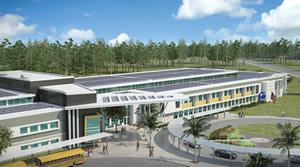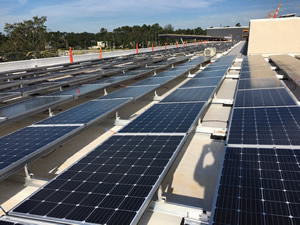Better than Bake Sale Funding for Capital Projects

PHOTO COURTESY OF SFL+A
You’ve just finished calculations and priorities for your school district’s desperately needed projects. You have estimated the total project costs, and adjusted for the timeframe and inflation. You have even added a contingency percentage for unanticipated costs. But now is the really hard part — time to find the funding for the project.
Traditional Methods of Funding
If your approach to funding is traditional, you know there are the usual suspects, the three methods for funding capital projects: general obligation bonds, certificates of participation and pay-as-you-go.
General Obligation Bonds require a positive vote on a referendum, a sale of the funding vehicle obligating the payment of the debt plus interest by a specific time, and the release of funds by the issuing entity. There are regulations regarding the referendums margin of passage, and the interest rate will be dependent upon the agency’s ability to pay (bond rating). Also, if the school system is not fiscally independent, the issuing government agency may restrict the flow of cash based upon their ability to pay.
Certificates of Participation, if allowed by state statute, are a similar funding mechanism to general obligation bonds except they do not require voter approval and are usually project specific.
Pay-as-you-Go funding is used when revenue exceeds obligations. Since school projects tend to be multi-year while revenue sources and obligations vary, pay-as-you-go funding requires a substantial amount of trust between agencies and of the three traditional methods of financing is used less frequently.
But many districts are finding themselves up against a longterm debt ceiling or a low tax base that makes traditional methods of funding almost impossible.
Alternative Funding Sources
Capital funding sources that are formula-based are promising because they seem to be more or less stable and reliable. Because of this some states have permitted local entities to use (with the approval of the voters) “special purpose local option sales taxes” to fund capital projects. Although the 2008 downturn reduced this funding source for a few years, it has been a relatively continuous source of revenue for capital outlay that is unencumbered by the usual political considerations once approved by the voters.
Michael Bobby, former CFO of Charleston County (SC) Schools and currently director of operations for Pinnacle Charter Academies, says that the revenue from the local option sales tax in Charleston has given that district the ability to tackle its maintenance backlog, the technology refresh, and the ongoing need for additional capacity. With the local option extended he anticipates Charleston will be debt free by 2020.
Quite a difference between that scenario and other districts in the state, that have very limited revenue to maintain and/or rebuild aging infrastructure and ultimately are forced to bulldoze their oldest maintenance backlogs and build new facilities — renovation by demolition. The drawback is that the local option tax takes time to work its way through the legislative and approval process and the facilities are needed yesterday.
Because additional capacity is often a result of growth, some local agencies have used “impact fees” to fund that additional capacity. These fees on new development are not always supported by the development community, but are an alternative to sole reliance upon property taxes as the funding source for capital projects.
Where state law permits, some districts have turned to “lease/purchase” as a way to fund their capital needs. The lease/purchase option, or capital leasing, is used infrequently by school districts. Most capital leasing firms require the leasee to be a bond-rated public agency. The total cost and timing of those leases are competitive with traditional financing. Some leasing firms will finance charter school facilities with this method. These costs (because of the perceived risks) tend to be much higher.
Facility ownership is the key issue here. Some districts feel that owning the school building is important. Others, taking their cue from large corporations, prefer to limit their facility inventory and the cost of ownership. They have begun to look at alternatives that still give them use of facilities without the burden of un-monetized inventory.
Still another option for facilities has been created by the interest in conserving resources and the potential to reduce and/or eliminate utility costs. Robbie Ferris of SfL+a Architects, an architectural firm with offices in the southeast United States, has been doing “energyneutral and energy-positive school projects” since 2006. “The first cost premium on these projects is about two-percent or $1 million. That works out to about a five to seven year payback depending upon the project configuration.”

PHOTO COURTESY OF SFL+A
Pay back. Photovoltaic arrays, like the ones on the roof of this building, are an essential part of alternative financing strategies for high-performance facilities generating a significant amount of energy and return on investment. By using energy-neutral and energy-positive school projects, the district can conserve resources and has the potential to reduce and/or eliminate utility costs. In some instances, the district can negotiate a performance contract. Although there may be some up-front costs, usually the district ends up paying what it would have in utility payments to a company that installs high-performance equipment that saves energy. The result, after five to seven years, is that the district inherits more efficient equipment and has not paid any more than it would have in utility costs.
Ferris’ firm has done 25 high-performance projects, with 11 of those being energy positive (i.e. they generate more power than they use). They have completed projects in small rural districts and larger more affluent ones as well. “If the district decides to do a high performance school, we can find a way to do it.” And that includes the financing.
Because the installed equipment is fairly sophisticated, there are two basic delivery models that have worked well. The first is a simple design/build/leaseback with an option to purchase. In this case the school district leases the building and the onus is on the developers to demonstrate that the building will perform as promised. Although in some cases, even when it does, the school district has not exercised their option to purchase. They prefer instead to continue to pay the lease payments (far lower than debt service on the full cost) and leave the developer responsible for the building systems.
The second high-performance delivery method is a design/build/operate model. In this case there is an extended optimization period (usually three years) in which the district owns the building, but the developer operates the building systems. This is similar to an extended commissioning period. Again, all systems are functioning as designed when they are turned over to the owner. This is often used when the lease/purchase arrangement is not permitted by state law.
Performance contracting has been used for many years as a tool to upgrade energyusing building systems. There is often an up-front payment required, after which the district pays what it would have normally paid in utility payments to a company that installs high-performance equipment that saves energy. The result after five to seven years is that the district inherits more efficient equipment and has not paid any more than it would have in utility costs.
When capital dollars get scarce, this funding method is sometimes used creatively. Michael Bobby recalls a project in Ohio several years ago when the equipment for a new building was funded through a performance contract. School districts often make this case during the annual budget cycle. Deferring major maintenance is more costly than funding replacements. This is similar to the performance contracting logic — the same or higher cost over time under the terms of the contract yields an upgraded performance.
Because deferred maintenance competes in the annual operating budget request with classroom expenditures, it usually loses. As unaddressed aging infrastructure becomes more of an issue, substantial increases in capital funding are a necessity. In the face of increasing downward pressure from taxpayers, many districts are forced to find other means of creating revenue. Similar to large corporations that have divested themselves of inventory through sale/leaseback, urban districts with attractive inventory are considering ways to monetize that property. Rural districts with much smaller tax bases are turning to creative financing mechanisms like the packages offered by Robbie Ferris and other industry funding innovators.
This article originally appeared in the issue of .